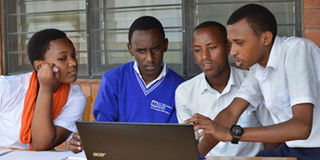Online learning deepens gaps in education sector

Students study online. PHOTO/FILE
What you need to know:
- Parents need to be vigilant in having routine and sometimes impromptu checks of phones to monitor their children’s browser and chat history on social media platforms to make sure their children remain safe to learn online.
The impact of the Covid-19 pandemic on the education sector has been severe. For as many as 15 months or more, children across the country have not been in school.
As the country has been dealing with the skyrocketing cases of the virus, parents and schools have been grappling with how they can keep children engaged with academic work. The answer to this was online studies.
Private schools and teachers have come up with all sorts of online programmes to keep learners busy. This has run alongside the government programmes of availing radio and television classes.
Online studying has not been a smooth ride. It has come with a set of challenges that make it an unfair substitute to the conventional learning that we hitherto knew.
Online learning is not accessible to all children because of the expense involved. The cost of paying the teachers together with the fees needed to purchase data leave most parents stretched.
The costs involved to pay teachers range from Shs10,000 a day to Shs50,000 a week per student. On top of that, parents need to buy data of about 1GB, which costs about Shs5,000. These costs have left out most of students as the parents cannot afford.
On the other hand, online studies are not accessible to everyone for the fact that the infrastructure involved isn’t owned by a vast majority of the learners in the country.
One needs to have a computer or at least a smartphone to be able to access online learning spaces such as Zoom and WhatsApp. This dynamic has left most if not all children in rural areas without any form of schooling.
Online learning has opened old wounds as far as learning for the girl-child is concerned. In several households that have been able to access these learning platforms, precedence has been given to the boys sometimes not deliberately, but inadvertently. The fact that girls still bear the primary responsibility for household chores has presented them with the challenge of having to juggle them with classes.
The result has been that they have either missed their classes or attended them when they are too tired to concentrate. This, if anything, reminds us that our society is still patriarchal, and a lot still has to be done to bring the girl child to the same equal footing as the boy.
Parents have also been introduced to a new challenge.
Online learning has left the children open to an array of online predators.
Risks range from individuals who seek to abuse children sexually to children’s easy access to pornography.
Children having phones has made it easy for wrong-intentioned people to target them. These people are sometimes as close as their own teachers who now find it easy to mislead the children.
Additionally, children are easily exposed to pornography, as some of the websites they visit for their studies contain pop-up adverts which usually lead them pornography sites.
The challenges the parents face from the advent of online learning are diverse and perhaps some - like the ones involving cost and infrastructural implications – do not have a short-term fix.
However, for those attending regular online classes, a hands-on approach is needed if they are to curtail the vice of predators or even find out if their children are engaged in it.
Parents need to be vigilant in having routine and sometimes impromptu checks of phones to monitor their children’s browser and chat history on social media platforms to make sure their children remain safe to learn online.
Stella Hiire, Kalinabiri S.S




